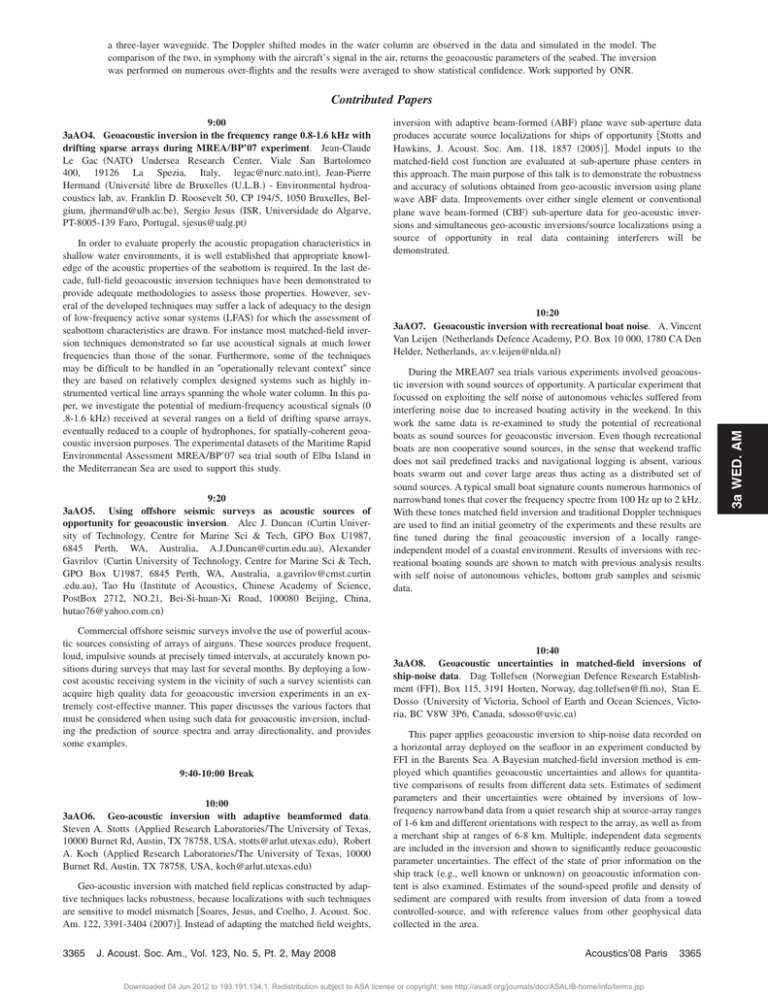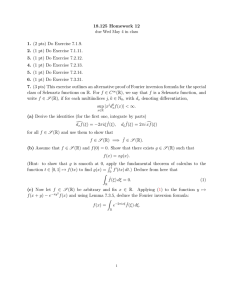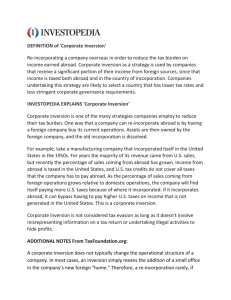Document 12779580
advertisement

a three-layer waveguide. The Doppler shifted modes in the water column are observed in the data and simulated in the model. The comparison of the two, in symphony with the aircraft’s signal in the air, returns the geoacoustic parameters of the seabed. The inversion was performed on numerous over-flights and the results were averaged to show statistical confidence. Work supported by ONR. Contributed Papers In order to evaluate properly the acoustic propagation characteristics in shallow water environments, it is well established that appropriate knowledge of the acoustic properties of the seabottom is required. In the last decade, full-field geoacoustic inversion techniques have been demonstrated to provide adequate methodologies to assess those properties. However, several of the developed techniques may suffer a lack of adequacy to the design of low-frequency active sonar systems 共LFAS兲 for which the assessment of seabottom characteristics are drawn. For instance most matched-field inversion techniques demonstrated so far use acoustical signals at much lower frequencies than those of the sonar. Furthermore, some of the techniques may be difficult to be handled in an ⬙operationally relevant context⬙ since they are based on relatively complex designed systems such as highly instrumented vertical line arrays spanning the whole water column. In this paper, we investigate the potential of medium-frequency acoustical signals 共0 .8-1.6 kHz兲 received at several ranges on a field of drifting sparse arrays, eventually reduced to a couple of hydrophones, for spatially-coherent geoacoustic inversion purposes. The experimental datasets of the Maritime Rapid Environmental Assessment MREA”BP’07 sea trial south of Elba Island in the Mediterranean Sea are used to support this study. 9:20 3aAO5. Using offshore seismic surveys as acoustic sources of opportunity for geoacoustic inversion. Alec J. Duncan 共Curtin University of Technology, Centre for Marine Sci & Tech, GPO Box U1987, 6845 Perth, WA, Australia, A.J.Duncan@curtin.edu.au兲, Alexander Gavrilov 共Curtin University of Technology, Centre for Marine Sci & Tech, GPO Box U1987, 6845 Perth, WA, Australia, a.gavrilov@cmst.curtin .edu.au兲, Tao Hu 共Institute of Acoustics, Chinese Academy of Science, PostBox 2712, NO.21, Bei-Si-huan-Xi Road, 100080 Beijing, China, hutao76@yahoo.com.cn兲 Commercial offshore seismic surveys involve the use of powerful acoustic sources consisting of arrays of airguns. These sources produce frequent, loud, impulsive sounds at precisely timed intervals, at accurately known positions during surveys that may last for several months. By deploying a lowcost acoustic receiving system in the vicinity of such a survey scientists can acquire high quality data for geoacoustic inversion experiments in an extremely cost-effective manner. This paper discusses the various factors that must be considered when using such data for geoacoustic inversion, including the prediction of source spectra and array directionality, and provides some examples. 9:40-10:00 Break 10:00 3aAO6. Geo-acoustic inversion with adaptive beamformed data. Steven A. Stotts 共Applied Research Laboratories”The University of Texas, 10000 Burnet Rd, Austin, TX 78758, USA, stotts@arlut.utexas.edu兲, Robert A. Koch 共Applied Research Laboratories”The University of Texas, 10000 Burnet Rd, Austin, TX 78758, USA, koch@arlut.utexas.edu兲 Geo-acoustic inversion with matched field replicas constructed by adaptive techniques lacks robustness, because localizations with such techniques are sensitive to model mismatch 关Soares, Jesus, and Coelho, J. Acoust. Soc. Am. 122, 3391-3404 共2007兲兴. Instead of adapting the matched field weights, 3365 J. Acoust. Soc. Am., Vol. 123, No. 5, Pt. 2, May 2008 inversion with adaptive beam-formed 共ABF兲 plane wave sub-aperture data produces accurate source localizations for ships of opportunity 关Stotts and Hawkins, J. Acoust. Soc. Am. 118, 1857 共2005兲兴. Model inputs to the matched-field cost function are evaluated at sub-aperture phase centers in this approach. The main purpose of this talk is to demonstrate the robustness and accuracy of solutions obtained from geo-acoustic inversion using plane wave ABF data. Improvements over either single element or conventional plane wave beam-formed 共CBF兲 sub-aperture data for geo-acoustic inversions and simultaneous geo-acoustic inversions”source localizations using a source of opportunity in real data containing interferers will be demonstrated. 10:20 3aAO7. Geoacoustic inversion with recreational boat noise. A. Vincent Van Leijen 共Netherlands Defence Academy, P.O. Box 10 000, 1780 CA Den Helder, Netherlands, av.v.leijen@nlda.nl兲 During the MREA07 sea trials various experiments involved geoacoustic inversion with sound sources of opportunity. A particular experiment that focussed on exploiting the self noise of autonomous vehicles suffered from interfering noise due to increased boating activity in the weekend. In this work the same data is re-examined to study the potential of recreational boats as sound sources for geoacoustic inversion. Even though recreational boats are non cooperative sound sources, in the sense that weekend traffic does not sail predefined tracks and navigational logging is absent, various boats swarm out and cover large areas thus acting as a distributed set of sound sources. A typical small boat signature counts numerous harmonics of narrowband tones that cover the frequency spectre from 100 Hz up to 2 kHz. With these tones matched field inversion and traditional Doppler techniques are used to find an initial geometry of the experiments and these results are fine tuned during the final geoacoustic inversion of a locally rangeindependent model of a coastal environment. Results of inversions with recreational boating sounds are shown to match with previous analysis results with self noise of autonomous vehicles, bottom grab samples and seismic data. 10:40 3aAO8. Geoacoustic uncertainties in matched-field inversions of ship-noise data. Dag Tollefsen 共Norwegian Defence Research Establishment 共FFI兲, Box 115, 3191 Horten, Norway, dag.tollefsen@ffi.no兲, Stan E. Dosso 共University of Victoria, School of Earth and Ocean Sciences, Victoria, BC V8W 3P6, Canada, sdosso@uvic.ca兲 This paper applies geoacoustic inversion to ship-noise data recorded on a horizontal array deployed on the seafloor in an experiment conducted by FFI in the Barents Sea. A Bayesian matched-field inversion method is employed which quantifies geoacoustic uncertainties and allows for quantitative comparisons of results from different data sets. Estimates of sediment parameters and their uncertainties were obtained by inversions of lowfrequency narrowband data from a quiet research ship at source-array ranges of 1-6 km and different orientations with respect to the array, as well as from a merchant ship at ranges of 6-8 km. Multiple, independent data segments are included in the inversion and shown to significantly reduce geoacoustic parameter uncertainties. The effect of the state of prior information on the ship track 共e.g., well known or unknown兲 on geoacoustic information content is also examined. Estimates of the sound-speed profile and density of sediment are compared with results from inversion of data from a towed controlled-source, and with reference values from other geophysical data collected in the area. Acoustics’08 Paris Downloaded 04 Jun 2012 to 193.191.134.1. Redistribution subject to ASA license or copyright; see http://asadl.org/journals/doc/ASALIB-home/info/terms.jsp 3365 3a WED. AM 9:00 3aAO4. Geoacoustic inversion in the frequency range 0.8-1.6 kHz with drifting sparse arrays during MREA”BP’07 experiment. Jean-Claude Le Gac 共NATO Undersea Research Center, Viale San Bartolomeo 400, 19126 La Spezia, Italy, legac@nurc.nato.int兲, Jean-Pierre Hermand 共Université libre de Bruxelles 共U.L.B.兲 - Environmental hydroacoustics lab, av. Franklin D. Roosevelt 50, CP 194”5, 1050 Bruxelles, Belgium, jhermand@ulb.ac.be兲, Sergio Jesus 共ISR, Universidade do Algarve, PT-8005-139 Faro, Portugal, sjesus@ualg.pt兲





